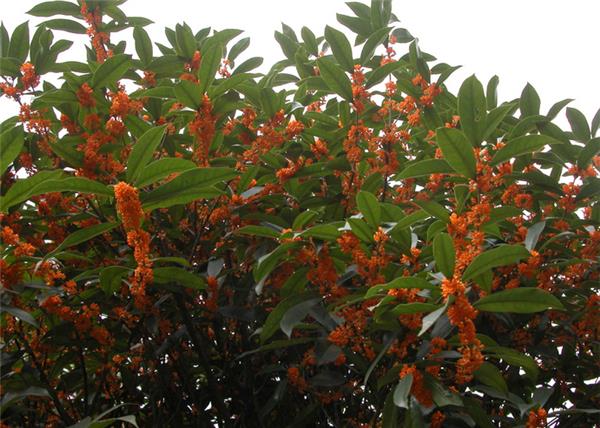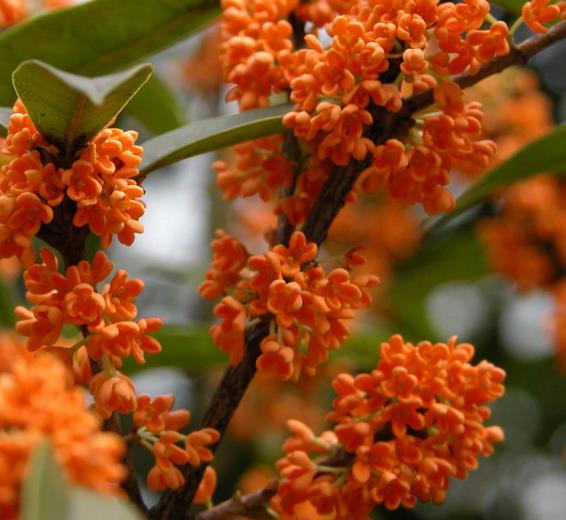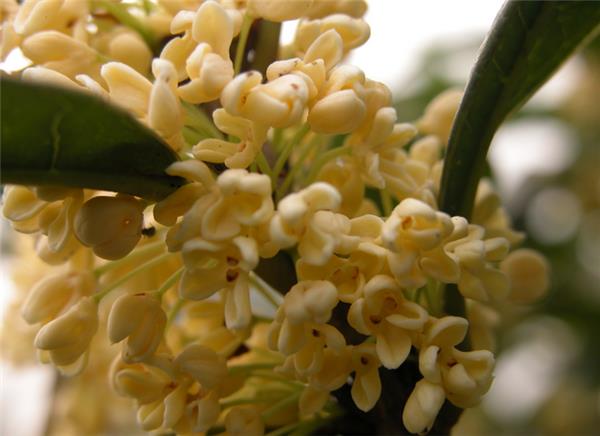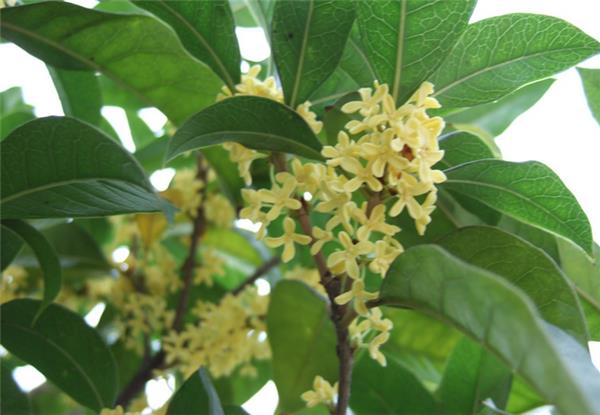How to grow fragrant and pleasant Japanese laurel
Japanese osmanthus is a new variety with the most fragrant flowers, the longest flowering period and the fastest growth rate in the sweet-scented osmanthus family. It gets its name because of its continuous flowering and rich aroma. Now let's take a look at the knowledge of cinnamon.

I. introduction of Japanese cinnamon
Osmanthus fragrans is a variety of sweet-scented osmanthus (sweet clover). It has many branches, short internodes, smooth leaves, green color, few-toothed or non-serrated leaves. Japanese cinnamon, evergreen shrub of Oleaceae. Strong branches can grow more than one meter in that year, and when they bloom, the trees are yellow and silver, with clusters of flowers, overflowing with fragrance and refreshing. Cinnamon has a very significant advantage: the flower stem protruding green leaves, can have flowers all the year round, and flowers continue to bloom. Its flower buds can differentiate continuously, and it has the strange characteristics that spring buds bloom and Lignified old branches can also produce dense buds and blossom. As a result, the long-term flowering and the continuity of flowering of cinnamon were ensured. In that year, the two-leaf seedlings bloomed, which is difficult to compare with ordinary sweet-scented osmanthus. And good adaptability, cold and drought tolerance, easy to plant and easy to live.
Japanese cinnamon avoid dust, sprayers should be used to rinse the leaves with water to keep the leaves clean. Flowerpots should not be near places with high concentration of harmful gases such as soot. Cinnamomum chinense has the same water requirements as other flowers and trees, too dry and wet soil will affect the growth and development. It is found that young branches and leaves wilt, so the flowerpot should be put into a clear water basin at 1/4 of the basin soil for about 1 hour to return to normal. Excessive water will also lack oxygen and rot the roots. Japanese cinnamon has few diseases and insect pests, and shell insects and red spiders can be sprayed with 800-1000 times quinathion solution.

Second, the production of Japanese cinnamon bonsai
Rapid cultivation of bonsai
Dig rootstocks before sprouting in spring, go up the mountain to dig up perennial and well-shaped mountain white wax. Trim according to the natural shape of the original pile. Be sure to leave 2-4 stumps and 10-15 cm for each stem. Wrap the cut in a plastic bag and remove the plastic bag after germination to prevent moisture loss and dry the dry part of the pile. Then plant it in a flowerpot with the right caliber. After the Qingming Festival, when the new buds on the pile stem grow to 15 centimeters, 2-4 thick buds (that is, one for each pile stem) are left in the appropriate place, and the rest are erased. When the remaining branches are semi-lignified or lignified, they can be grafted, and the time is generally from May to August.

two。 Grafting method
(1) by selecting rootstocks and scions of equal thickness, use a sharp knife to cut the cutting surface with a length of about 3 meters and a thickness of 1 inch in diameter, and the cutting surface should be smooth. Put the two cutters together, align the anvil and ear to form a layer, bind and firm with plastic strips, place them in the sun, and stop the management. Generally about 35 days, the healing is firm, then the rootstock can be cut off in the upper part of the grafting site, and the ear plant can be separated in the lower part. In the future, the binding rope will be lifted in time according to the growth strength. This kind of grafting method starts from leaning to the unbinding rope and the scion blossoms normally.
(2) semi-lignified or lignified cinnamon was selected as scion. Cut into 2-3 leaf segments, the lower end of the leaf with about 2 cm long branches, cut off the leaf 1 big 3. Use a sharp knife to cut the lower end of the scion into a wedge with a length of about 1.5 cm on one side and a shorter one on the other. Cut about 1.5 cm at the grafting site of the rootstock, with a tongue-shaped knife edge as deep as 1 to 3 in diameter. Immediately cut the scion length and split the rootstock facing the inside wedge, and align the rootstock and spike to form a layer. Tie it with a plastic strip, cover it with a plastic bag and place it in the shade. About 40 days, the interface healed firmly, take off the plastic bag, go to the upper rootstock of the grafting site, carry on the normal management, can grow buds and blossom normally. The unbinding situation is the same as the connection.
(3) after successful maintenance and grafting, it can be maintained on the ground together with the basin. The cake fertilizer released by bubble rot was applied once every half a month, and photosynthetic micro-fertilizer was sprayed on the leaves. When it is found that leaf spot disease can be controlled by spraying 500 times Kangkuling. If there are red spiders, you can spray 2000 times peach Xiaoling to control. When the outdoor is about 0 ℃, you can move it indoors and put it in the sunshine place of level 5. When the lowest outdoor temperature in spring is more than 3 ℃, it can be moved out of the room and maintained on the ground again.
(4) according to the natural shape of the original pile, it can be trimmed to form straight dry type, oblique dry type, horizontal dry type, dry type, exposed root type and so on. No matter what kind of plastic surgery, we must not act in haste, resulting in haste makes waste. Especially exposed root style, should be fractional, less exposed each time, be sure to be in a hurry. Generally, it can be trimmed in about two years.
(5) change the basin with a few days after grafting, maintenance, pruning and shaping, the heel can be planted in the top bonsai basin, put on the furnishings, plant moss, match the basin, and enjoy the wonderful elegant demeanor of Japanese cinnamon bonsai.

Key points of maintenance
Japanese cinnamon is light-resistant and shady, and the soil is suitable for loose soil with good water permeability, like fertilizer, moisture, cold and drought resistance, easy to plant and easy to live, few diseases and insect pests, no need for careful care. In the annual growth period of Cinnamomum chinense, the flowering habits and characteristics are different with the change of temperature and season, which can be divided into three periods.
The above is the knowledge of Japanese cinnamon. I hope I can help you.
Key points of maintenance
Japanese cinnamon is light-resistant and shady, and the soil is suitable for loose soil with good water permeability, like fertilizer, moisture, cold and drought resistance, easy to plant and easy to live, few diseases and insect pests, no need for careful care. In the annual growth period of Cinnamomum chinense, the flowering habits and characteristics are different with the change of temperature and season, which can be divided into three periods.
The above is the knowledge of Japanese cinnamon. I hope I can help you.
- Prev

Introduction and culture skills of blue-eyed chrysanthemum how to raise beautiful blue-eyed chrysanthemum
Introduction and culture skills of blue-eyed chrysanthemum how to raise beautiful blue-eyed chrysanthemum
- Next

The characteristics and detailed introduction of wild peony
The characteristics and detailed introduction of wild peony
Related
- Wuhan Hospital Iron Tree Blooming Result Was Instantly Frightened by the Gardener Master
- Which variety of camellia is the most fragrant and best? Which one do you like best?
- What is the small blue coat, the breeding methods and matters needing attention of the succulent plant
- Dormancy time and maintenance management of succulent plants during dormancy
- Minas succulent how to raise, Minas succulent plant pictures
- What are the varieties of winter succulent plants
- How to raise succulent plants in twelve rolls? let's take a look at some experience of breeding twelve rolls.
- Attention should be paid to water control for succulent plants during dormant period (winter and summer)
- Watering experience of twelve rolls of succulent plants
- Techniques for fertilizing succulent plants. An article will let you know how to fertilize succulent plants.

